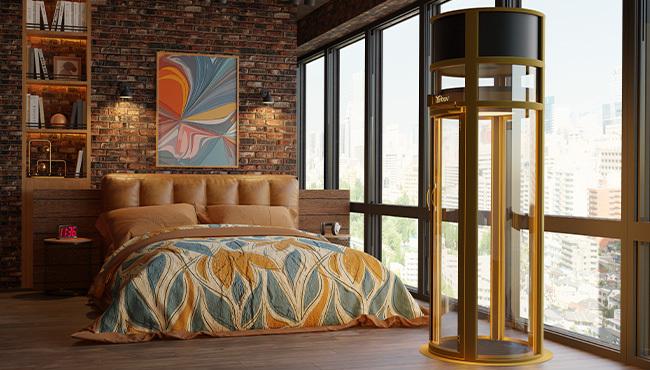Choosing the right elevator for your building in Malaysia is a crucial decision that affects the functionality, safety, and value of your property. Whether you are looking to install a new elevator in a residential building, a commercial property, or a high-rise, several factors need careful consideration. This comprehensive guide will walk you through the essential aspects to consider, ensuring you make an informed and suitable choice.
Understanding the Different Types of Elevators
1. Hydraulic Elevators
Hydraulic elevators are commonly used in low to mid-rise buildings. They operate using a hydraulic pump that pushes fluid into a cylinder, moving the elevator up and down. These elevators are known for their smooth ride and cost-effectiveness but require more space for machinery.
2. Traction Elevators
Traction elevators are suitable for high-rise buildings and use a system of ropes and counterweights. They are faster and more energy-efficient compared to hydraulic elevators. Traction elevators come in two main types: geared and gearless.
3. Machine Room-Less (MRL) Elevators
MRL elevators do not require a separate machine room, making them ideal for buildings with space constraints. They are energy-efficient and suitable for both mid-rise and high-rise buildings.
4. Pneumatic Elevators
Pneumatic elevators, also known as vacuum elevators, use air pressure to move the cab. They are perfect for residential buildings due to their compact size and minimal structural requirements.
Key Features to Consider
1. Load Capacity
The load capacity of an elevator is a critical factor. Consider the maximum number of people or the weight it needs to carry. Residential elevators typically have lower capacity requirements than commercial elevators.
2. Speed
Elevator speed varies depending on the building type and height. High-rise buildings need faster elevators to reduce wait times, while residential buildings can have slower, more comfortable rides.
3. Safety Features
Safety is paramount when choosing an elevator. Look for features like emergency brakes, alarm systems, backup power, and door sensors. Compliance with local safety regulations is essential.
4. Energy Efficiency
Energy-efficient elevators reduce operational costs and are environmentally friendly. Consider elevators with regenerative drives, LED lighting, and standby modes to save energy.
5. Design and Aesthetics
The design and aesthetics of an elevator should complement the building’s architecture. Customizable cabin designs, lighting, and finishes allow for a tailored look that enhances the overall appeal of the property.
Factors to Consider When Choosing an Elevator
1. Building Type and Usage
The type of building and its usage significantly influence the choice of an elevator. Residential buildings may prioritize comfort and aesthetics, while commercial buildings focus on speed and capacity.
2. Budget
Budget is a crucial factor. Hydraulic elevators are generally more affordable upfront, but traction and MRL elevators can be more cost-effective in the long run due to lower maintenance and energy costs.
3. Space Availability
The available space in your building determines the type of elevator you can install. MRL and pneumatic elevators are ideal for buildings with limited space.
4. Maintenance and Service
Regular maintenance is essential for the safe and efficient operation of elevators. Choose a reputable elevator provider like Nibav Home Lifts, known for reliable service and support.
Benefits of Choosing Nibav Home Lifts
1. Expertise and Experience
Nibav Home Lifts has extensive experience in providing high-quality elevators tailored to the specific needs of buildings in Malaysia. Their expertise ensures a smooth installation process and reliable performance.
2. Innovative Technology
Nibav Home Lifts offers state-of-the-art elevator technology, including energy-efficient systems, advanced safety features, and modern designs.
3. Customization Options
Nibav Home Lifts provides a range of customization options to match the aesthetic and functional requirements of your building. From cabin interiors to control panels, every detail can be personalized.
4. Excellent Customer Support
Customer support is a priority for Nibav Home Lifts. Their dedicated team ensures timely maintenance, quick issue resolution, and comprehensive after-sales service.
Step-by-Step Guide to Choosing the Right Elevator
Step 1: Assess Your Needs
Identify the specific needs of your building, including load capacity, speed, and usage patterns. Consider the building’s architecture and space constraints.
Step 2: Set a Budget
Determine your budget for the elevator installation, including initial costs, maintenance, and operational expenses.
Step 3: Research and Compare
Research different types of elevators and compare their features, benefits, and costs. Consult with experts like Nibav Home Lifts to understand the best options for your building.
Step 4: Evaluate Safety and Compliance
Ensure that the elevator complies with local safety regulations and standards. Check for essential safety features and certifications.
Step 5: Customize Your Elevator
Work with your elevator provider to customize the design and features of the elevator. Choose finishes, lighting, and control options that align with your building’s style.
Step 6: Plan for Maintenance
Establish a maintenance plan to keep the elevator in optimal condition. Regular inspections and servicing are crucial for safety and performance.
Conclusion
Choosing the right elevator for your building in Malaysia involves careful consideration of various factors, from the type and features to budget and maintenance. By understanding your needs and working with a reputable provider like Nibav Home Lifts, you can ensure a seamless installation and long-term satisfaction.
Nibav Home Lifts offers expert guidance, innovative technology, and exceptional customer support, making them the ideal partner for your elevator needs. Contact Nibav Home Lifts today to learn more about their range of elevators and how they can help you choose the perfect solution for your building.
